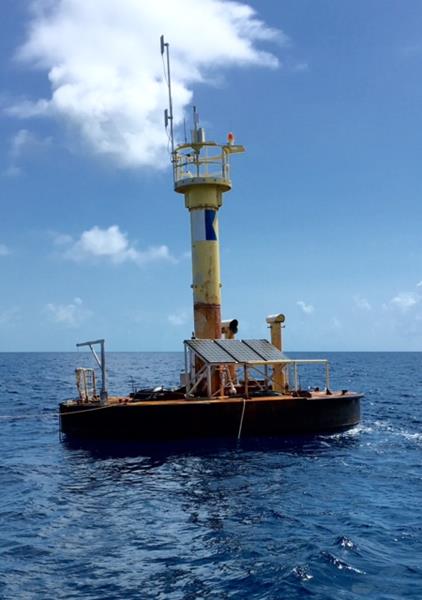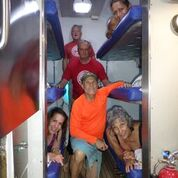![]()
- Aquarius Underwater
Laboratory
- Ground Breaking Coral Research at the Frost Museum of Science
- Grand Cayman Delivers
Grand Diving
- A Good News Story
- The Zen of Alan Watts As Applied to Diving
- Muddy Waters
- The Green Flash
- Dive Tip: DeFog
- Newsletter Delivery Options
- Email or Address Change?
- T-Shirts For Sale
- Active Divers Guidelines & Policies
Two years ago, eleven intrepid Active Divers Association members enjoyed something that fewer than 1,600 of the world’s approximately 3 million certified divers (only about one-half of one percent) have experienced: a mission aboard the Aquarius Underwater Laboratory and Habitat. Part of the Florida International University (FIU) Marine Education and Research Initiative, the Aquarius Program operates the world’s only full time undersea research laboratory, dedicated to the study and preservation of marine ecosystems worldwide. In the two years since that mission, Active Divers has continued our relationship with Aquarius, forming a committee to plan future missions aboard the habitat and funding partial scholarships for two FIU students studying marine sciences. This is a call for volunteers to join that Aquarius Committee and to help us continue our collaboration with that unique underwater program. If, after reading this article you are willing to add your name to the Aquarius Committee roster, please email me at roy@wassonandassociates.com. We need your help and you will be part of an exciting project that will add new dimensions to your diving experiences.
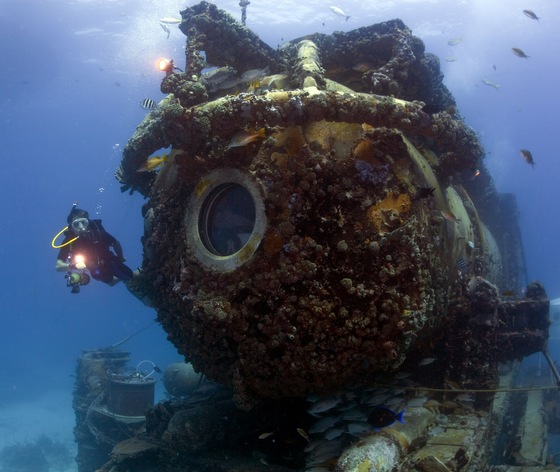
Aquarius is a complex diving system that consists of the lab below the ocean; a life support buoy on the surface that houses power generators, air compressors and data connections; and a mission control center in Islamorada. Using a technique known as saturation diving, Aquarius residents can spend days to weeks under water conducting research that cannot be accomplished anywhere else on the planet.
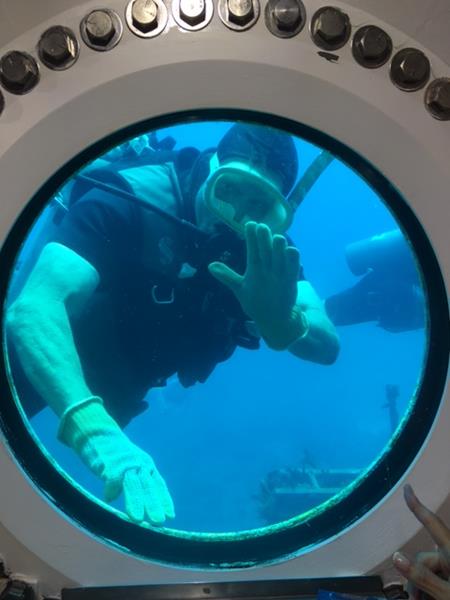
Aquarius was built in Victoria, Texas in 1986. Underwater operations first began in the United States Virgin Islands, in St. Croix’s Salt River Canyon (now a national park and previously home to Hydrolab, the predecessor to Aquarius), in 1988. After thirteen missions (and Hurricane Hugo), Aquarius was relocated to Wilmington, North Carolina where it was refurbished over an eighteen-month period by the National Undersea Research Center at the University of North Carolina Wilmington (UNCW). Aquarius remained in Wilmington until 1992 when it was deployed in to the Florida Keys National Marine Sanctuary four miles off Key Largo.
After conducting twenty missions, Aquarius was retrieved in 1996 due to funding constraints. New operating protocols were then developed, funding was restored, and Aquarius was refurbished at Harbor Branch Oceanographic Institution, Florida, during 1997. In 1998, it was redeployed to Conch Reef.
![]()
This summer I landed an internship at the Frost Museum of Science. I work in the “Inventor in Residence Laboratory.” This wet lab is a satellite lab from the University of Miami’s Rosenstiel School of Marine and Atmospheric Science. An experiment is being conducted by Dr. Andrew Baker and Dr. Rivah Winter. The focus of the experiment is to grow corals that are more resilient in warm oceans.

Less than one tenth of a fraction of earth’s ocean contain coral reefs and more than 24% of marine animals depend on coral reefs at some point in their lives. With 2016-2017 being a hot summer, most of the corals in the Florida Keys were sent to Davy Jones’ locker and 2018 isn’t looking good either. The University of Miami’s Rescue a Reef program has noted that even though 92% of the transplanted corals from a nursery survive, they will not survive an exposure to overly warm or cool temperatures.
In this first of its kind experiment, we are replacing staghorn
coral’s algae community with a more heat and light resistant algae
known as clade D zooxanthellae. 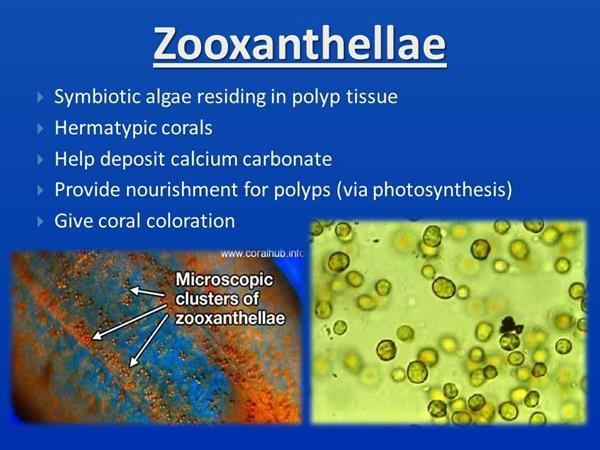
All reef-building corals live in a symbiotic relationship with microscopic algae known as zooxanthellae. The zooxanthellae lives in the polyp cell and produces energy by a process of photosynthesis. When the coral polyp is exposed to overly warm or cool temperatures, it can trigger toxins to be realized. When the coral host realized their partner is releasing toxins the corals dispel the algae.
Dr. Baker’s group discovered that corals paired with clade D zooxanthellae resist bleaching. This may explain why clade D symbionts tend to become more common in reefs after mass coral bleaching events.
In the laboratory, we are able to make corals take on greater numbers of clade D zooxanthellae through a process called “stress hardening”. Ultimately, the experiment will be tested in the ocean and help rebuild reefs in Florida and around the world.
![]()
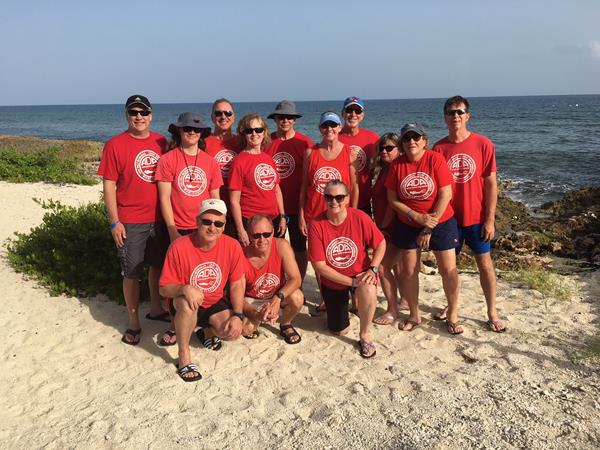 Thirteen ADA
divers took the short one-hour flight from Miami to Grand Cayman to
spend a week diving from July 7-14. Grand Cayman is known for its
crystal clear warm water and abundant marine life. We knew this year
we were due for a safe-bet dive trip, and Grand Cayman didn't
disappoint.
Thirteen ADA
divers took the short one-hour flight from Miami to Grand Cayman to
spend a week diving from July 7-14. Grand Cayman is known for its
crystal clear warm water and abundant marine life. We knew this year
we were due for a safe-bet dive trip, and Grand Cayman didn't
disappoint.
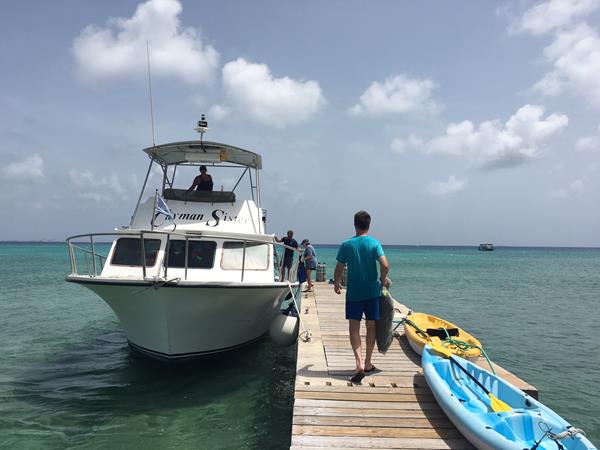 We stayed at the
Cobalt Coast resort on the north coast of Grand Cayman. We had an
all-inclusive meal package and a large patio table where we could dine
together poolside every night overlooking the ocean. Dinner began
every night with a beautiful sunset and each day began with beautiful
diving. Each morning we would board Reef Divers' Twin Sister for three
dives a day with valet diving, where all was required that you sit
down while brawny lads carried everything to you.
We stayed at the
Cobalt Coast resort on the north coast of Grand Cayman. We had an
all-inclusive meal package and a large patio table where we could dine
together poolside every night overlooking the ocean. Dinner began
every night with a beautiful sunset and each day began with beautiful
diving. Each morning we would board Reef Divers' Twin Sister for three
dives a day with valet diving, where all was required that you sit
down while brawny lads carried everything to you. 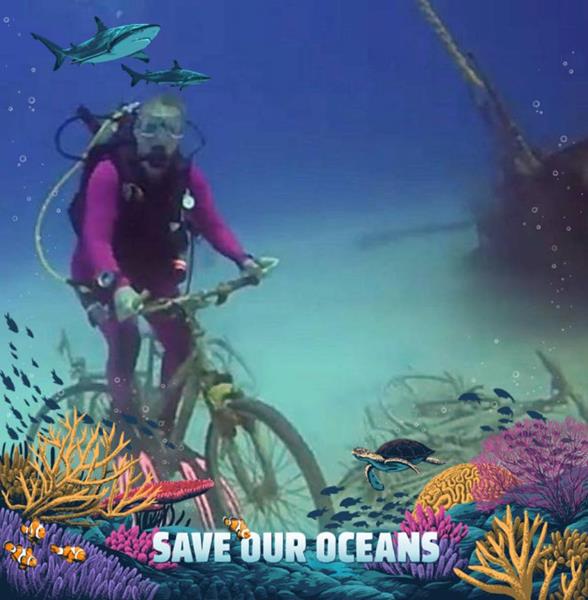
One nice feature of this resort is the long pier with free air tanks and shore diving areas. We completed three shore dives (one afternoon and two night dives) from this pier, where you could go from 5 to 75 feet in about ten minutes kicking at a normal pace.
Unique to this trip was three generations of divers who traveled from St. Louis to be with us: Dennis Fiehler, son Jason and grandson Connor. It's true that the family who plays together stays together.
Diving highlights included the schooling horse-eyed jacks of the Doc Poulson wreck, Stingray City and the "Stingray High-Five" made famous by Connor Fiehler, Kill Puffer reef with the 500-lb. loggerhead turtle being chased by the paparazzi, Bonnie's arch with a beautiful natural arch of coral and schooling fish, Hepp's Pipeline with unbelievable colors, and the Oro Verde wreck complete with dive biking!
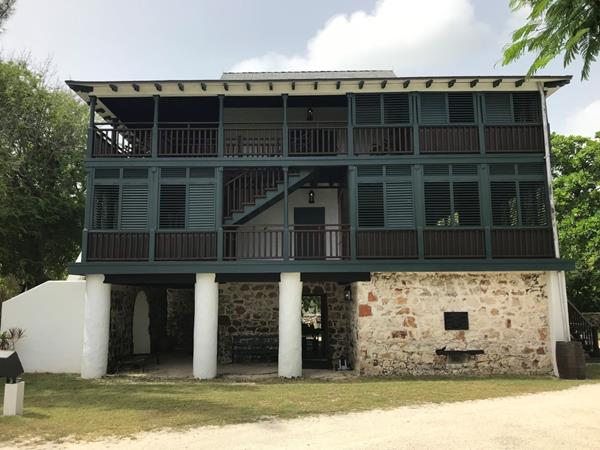 On the last day,
nine hardy explorers set out on Friday afternoon after the last dive
to see some of Grand Cayman above ground. The first place we visited
was Pedro
St. James Castle, also known as Pedro's Castle. It is the oldest
existing building in the Cayman Islands. Located on the southern coast
of Grand Cayman Island, the manor is a restoral of the original 1780
house, and the home of plantation owner William Eden. In 1831, it
served as a rendezvous point for the first elected parliament in the
Cayman Islands; the location has since been known as the birthplace of
democracy in Cayman. During this meeting, the decision was made
amongst the island's leading citizens to vote for elected
representatives. Four years later, in 1835, the Slavery Abolition Act was read from the stone
archway of the building.
On the last day,
nine hardy explorers set out on Friday afternoon after the last dive
to see some of Grand Cayman above ground. The first place we visited
was Pedro
St. James Castle, also known as Pedro's Castle. It is the oldest
existing building in the Cayman Islands. Located on the southern coast
of Grand Cayman Island, the manor is a restoral of the original 1780
house, and the home of plantation owner William Eden. In 1831, it
served as a rendezvous point for the first elected parliament in the
Cayman Islands; the location has since been known as the birthplace of
democracy in Cayman. During this meeting, the decision was made
amongst the island's leading citizens to vote for elected
representatives. Four years later, in 1835, the Slavery Abolition Act was read from the stone
archway of the building. 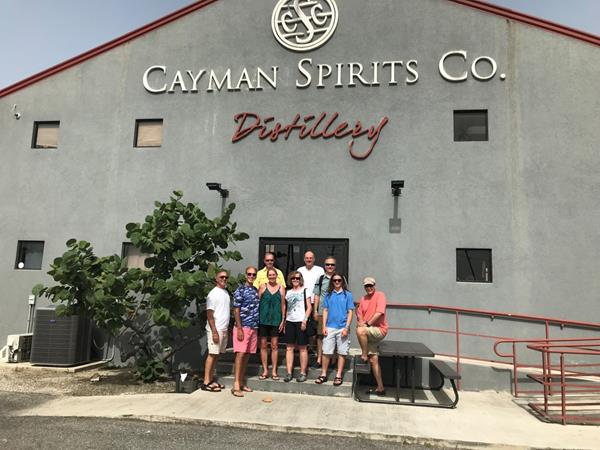
By the 1970s, the building was reduced to ruin after decades of neglect. But In 1996, the house was restored, and an added area was used as a gathering place for locals, including a restaurant and bar. Trish, our guide, gave us the low-down on the building’s history, with an animated 25-minute show, and lead the tour of the house for us. After an hour we were back on our bus headed for our next stop, Cayman Spirits Company.
Based on some advice from Trip Advisor and the staff at Cobalt Coast, this was deemed the best “Rum Tasting and Distillery Tour” on the Island, and from what we experienced, we have to agree! The staff was animated and fun, playing 50’s, 60’s, 70’s, and 80’s music as we sampled each and every flavor of rum they had, followed by a “lightening round” where we could resample anything we liked. It was followed by a very informative tour of the distillery before we boarded our bus for the return trip to the resort. We all agreed, this was the “most bestest rum tasting ever”.
![]()
There is good news about the Oceans. I know I brought a lot of gloom and doom lately but here is the opposite side. The Ocean Conservancy (an advocate group for the Oceans) has received over $3 Billion dollars in commitments from countries and Non-Governmental Organizations (NGOs) during a two-day conference. Now that will help.
They work on
expanding the marine protected areas, sustainable fisheries, marine
pollution, the blue economy and maritime security. Each one will help
the oceans recover from the stresses they are under. It is critical
for the people living off the oceans. Forests may be the lands' green
lung, but the oceans are the earth's beating heart. It also addresses
the Oceans acidification. This is the increasing amount of carbon
admissions the Oceans receive. This harms shell-building animals such
as oysters, clams and mussels, not to mention the coral reefs
themselves.
They have also started a program called the Trash Free Seas Alliance. These are countries that are committed to removing and preventing trash from entering the oceans to begin with. All these endeavors are a great move in the right direction. Saving our Oceans. So there you have it: The Good News.
![]()
(Note: Alan Watts was a 20th century philosopher who popularized Eastern philosophy to Westerners)
You are a function of what the whole universe is doing in the same way that a wave is a function of what the whole ocean is doing.
![]()
Yes, it is an underwater superhero. Just kidding, does anyone really know what it is. Of course, it has to do with the oceans. It is one of the most elusive features of the gulf sunset. No wonder the Key West sunset festival is so popular. They are probably looking for the flash. On the other hand, they might just be getting prepared for their bar hunt and know nothing of the flash.
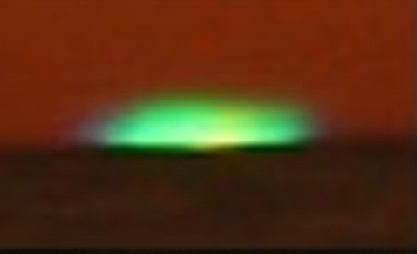
Let’s get down to details. Enough of this nonsense. The flash is a natural phenomenon. It is visible immediately after the sun dips below a clear horizon with no clouds or haze in the mix. It is the sun’s spectral bands being separated by the atmosphere (We may need a scientist* to explain that part). Only at sunset is the sun’s light diminished enough to see the flash. Red and yellow bands set before the sun does and the blue bands are scattered by the blue sky. The only remaining band is the green. Thus, the flash. Get it.? I am not sure I do but I never was good at science,
*Much like a prism bends light waves into their component colors, called dispersion, the sun’s angle to the atmosphere bends the sun’s visible rays into the familiar ROY G BIV (Red, Orange, Yellow, Green, Blue, Indigo, and Violet).--a Scientist
Return to Index![]()
If you dove at last year’s closing event you know what muddy waters are. Well, it wasn’t really muddy but it was a silt-out. I am still amazed that Rachael was able to train those divers. They definitely had an experience. This demonstrates Rachael’s expertise in training.
When you entered the waves were crashing and it was hard just to maintain your balance. You couldn’t even see your feet in 4 feet of water. This was the effect of the previous storms and hurricanes passing and it was challenging. Usually, it starts this way but once you get deep enough it will clear up. It wasn’t happening on this dive. This is one where your training had to kick in.
Diving in these conditions is like driving a car in real bad fog. You are a little apprehensive. This time the silt was very bad and not about to wash out with the tide. The best you could do is use that compass and stayed glued to it. The waves were turning you around every which way. Those familiar land marks never seemed to appear. At least I never noted any of them. I hugged the bottom and used my compass, when I could see it. It had to be in front of my nose. Paying attention to my dept gauge was a help in the direction department as well. After having enough of not catching any legal lobsters (a couple were too small) I decided this was not my day. I took a compass bearing and luckily came out close to where I entered. Some days that muddy water diving should be postponed. On other days it is a great training experience. This was one. Makes me recall the army saying: “If it ain’t raining we ain’t training.”
--by DeeperBlue.com
The Deeper Blue website has announced the probable dates for the annual Florida Keys reef spawning event. Dives on or around the full moon on August 26th or September 24th, 2018 will be an opportunity to witness coral mass spawning in the region.
Although the exact reasons that trigger corals to spawn are not exactly understood, there is strong evidence to indicate that there is a connection to lunar cycles, tide, water temperature and 24-hour light cycles. The event is monitored by scientists every year, with a reasonable degree of accuracy of prediction when the next event will be.To read the entire article, click on DeeperBlue.com.
Want your newsletter delivered via snail-mail? Contact the webmaster and request a printed copy. Be sure to put "Active Divers Newsletter" in the subject.
![]()
If so, please email or call us with your current information. You may send an email to: Dr. Dan Baeza, Membership Chair at ActiveDiversInfo@gmail.com. You can also call Dan at 954-260-8225 and leave a message with your new contact information.
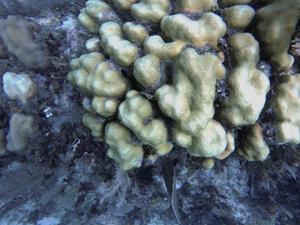
Active Divers T-Shirts For Sale
Show your pride in the best dive club anywhere! Sizes small, medium, large, xlarge, xxlarge. Some tank tops available also. All shirts are $10 each. CALL LON AT 305-251-4975 AND PLACE YOUR ORDER TODAY!. Lon will deliver it to you on your next dive
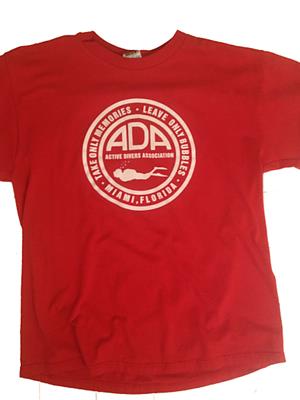
You're on the dive boat and about to plunge into the water, when you decide to squirt a little defogging agent into your mask. It is at that moment that you remember that you emptied the bottle on your last dive.
What to do? Hmmmm... Borrowing is always an option, but chances are, everyone is either in the water or on their way to the water. Well, just like an empty scuba tank is usually not completely empty, so is it with defog. Simply add a small amount of water, shake it around, and voila, instant defog.
Can't get the applicator nozzle off? No matter. Just squeeze the bottle, insert the tip into water, and let it vacuum up a small amount of water. Swish it around, and you're back in business.
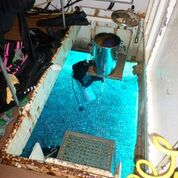 Our ADA mission
started early on a Saturday morning, with Aquarius staff members
meeting us at the program’s shore base in Islamorada at 7:30 a.m. to
complete paperwork, distribute gear, and begin our classroom
orientation. The Aquarius program’s commitment to safety and
professionalism is demonstrated by its requirement that divers use
program-issued regulators and buoyancy compensators, unless guest
divers have certificates documenting current inspections of their
own gear. For the next couple of hours our members received
classroom instruction on the history and purpose of Aquarius, its
facilities, and procedures we would use in visiting and occupying
the habitat. We learned about the role of the shore base, safety
measures in place, and the history of Aquarius in promoting research
of the marine environment.
Our ADA mission
started early on a Saturday morning, with Aquarius staff members
meeting us at the program’s shore base in Islamorada at 7:30 a.m. to
complete paperwork, distribute gear, and begin our classroom
orientation. The Aquarius program’s commitment to safety and
professionalism is demonstrated by its requirement that divers use
program-issued regulators and buoyancy compensators, unless guest
divers have certificates documenting current inspections of their
own gear. For the next couple of hours our members received
classroom instruction on the history and purpose of Aquarius, its
facilities, and procedures we would use in visiting and occupying
the habitat. We learned about the role of the shore base, safety
measures in place, and the history of Aquarius in promoting research
of the marine environment. 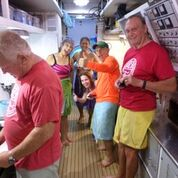 After the
onshore session, our ADA divers boarded two dive vessels for the
forty-five minute cruise to the habitat itself. Our dive plan called
for two one-hour dives, with one group visiting the exterior of the
structure on the first dive and the other group penetrating the
habitat, with a lunch break back topsides before a second dive in
which our groups switched destinations.
After the
onshore session, our ADA divers boarded two dive vessels for the
forty-five minute cruise to the habitat itself. Our dive plan called
for two one-hour dives, with one group visiting the exterior of the
structure on the first dive and the other group penetrating the
habitat, with a lunch break back topsides before a second dive in
which our groups switched destinations. 